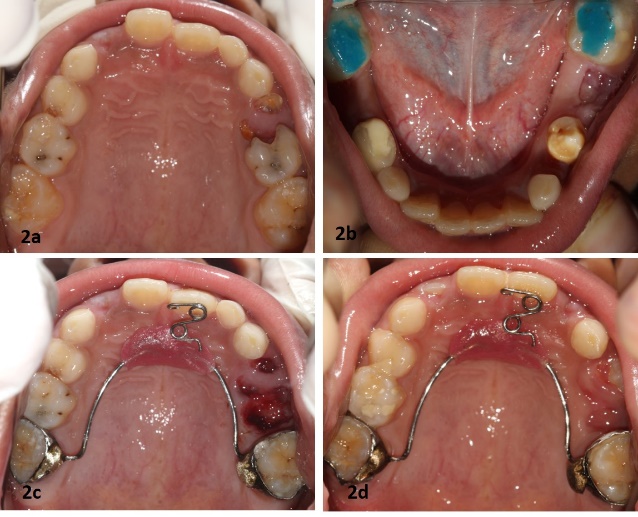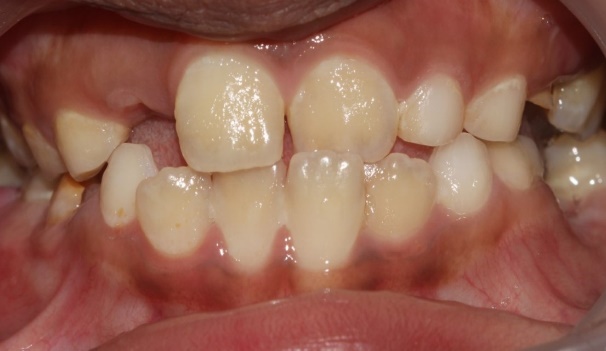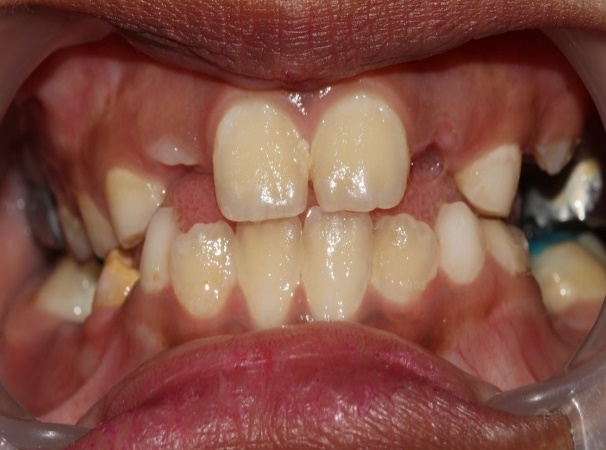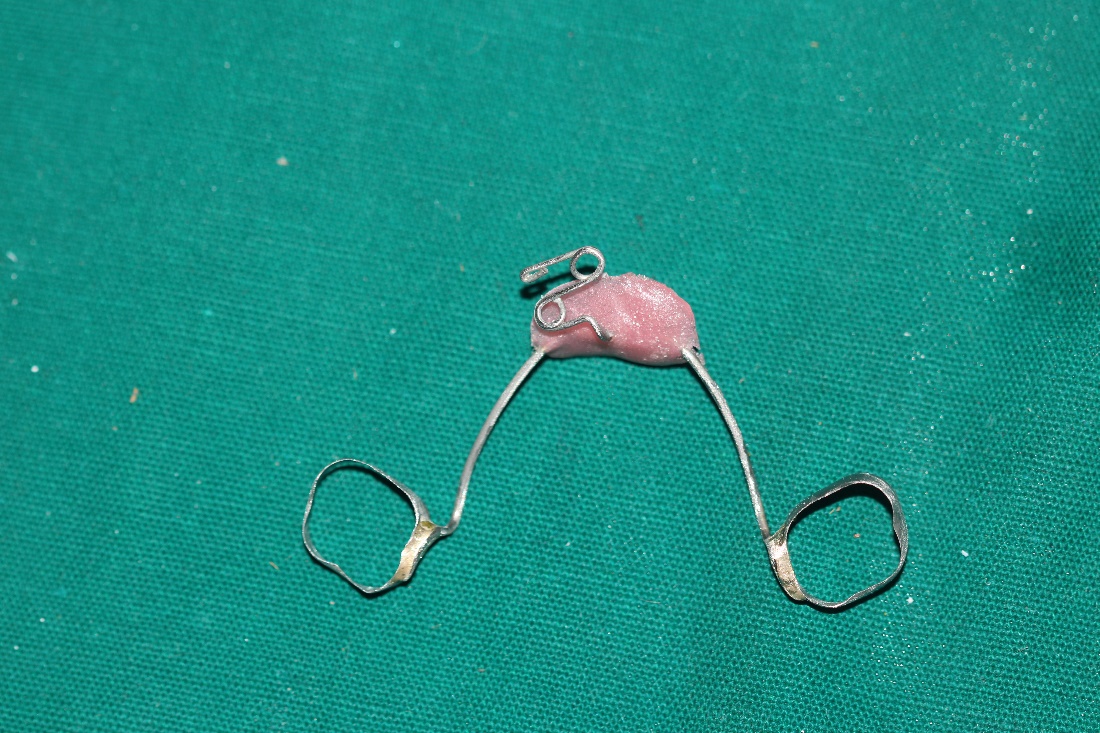Introduction
Premature loss of a deciduous tooth or a group of teeth can manifest as malocclusion in permanent dentition in the form of anterior and posterior cross-bite, impaction of permanent teeth, and supra eruption of opposing teeth. At a young age, it is reported to cause an earlier eruption of permanent successors and interfere with the harmony of permanent dentition resulting in crowding caused by the drifting of teeth towards the extraction space.1 The principal way to avoid these problems is to preserve primary teeth in the arch until their usual time of exfoliation. However, in cases where extraction of teeth is inevitable due to extensive caries or any other reason, the safest option to maintain arch space is by placing a space maintainer.2 Fixed space maintainers are usually indicated to maintain the space created by unilateral/bilateral premature loss of primary teeth in either of the arches.3 Traditionally, the treatment of choice for bilateral loss of teeth in the maxilla is a Nance appliance.4
Sometimes the clinicians face cases of complex malocclusion where crossbite and multiple grossly carious teeth can be present in the dentition concurrently. Anterior crossbite has a reported incidence of 4-5% which usually becomes evident during the early mixed dentition phase.5 It has been recommended to treat anterior crossbite as soon as it is encountered by the clinician. If untreated, can lead to abnormal enamel abrasion of the lower incisors, dental compensation of mandibular incisors leading to thinning of the labial alveolar plate, or gingival recession. The conventional removable appliances have a variable time period for crossbite correction which may range from as early as two weeks to two months. In certain cases, along with immediate correction of crossbite, there is a need to extract the primary molars immediately due to pain, intra-oral swelling, and infection. If a space maintainer is not placed shortly after the loss of the primary tooth, the opportunity to prevent space loss at the extraction site is lost. It was reported that there is an immediate space loss of 1.5 mm per arch side in the mandible and 1 mm in the maxilla.6
Hence, there is a need for an appliance that can cater to preventive and interceptive orthodontics simultaneously.
In the present case series, Nance palatal space maintainer was delivered to maintain the integrity of the arch, and the Z spring was secured in the Nance button for anterior crossbite correction.
Case Series
Case 1
A nine-year-old female patient reported with the chief complaint of grossly decayed teeth in the upper left back tooth region. Intraoral hard tissue examination showed root stumps in relation to 64 and single tooth crossbite in relation to 21 and 31 (Figure 1), class 1 molar relationship bilaterally, occlusal caries in 55, proximal caries in 65, and clinically missing 75 and 85. (Figure 2a,b) Moyers analysis showed +2 mm of space, indicating adequate space for maintenance in the maxilla, whereas on radiographic examination there was no need for a space maintainer in the mandibular arch. Hence, the treatment plan was the extraction of 64 and 65 (due to pathologic root resorption) followed by a modified Nance appliance with Z spring along with a restoration of 55. On 1st appointment, the measurement for the appliance was made using alginate impression material, the cast was poured, and the appliance was constructed.
Figure 2
Intra-oral photographs depicting correction ofcrossbite. a: Pre-operative maxillary occlusal photograph, b: Mandibular occlusal photograph showing posterior bite rise with blu bite composite on 36 and 46, c: Intra-operative maxillary occlusal photograph showing modified Nance appliance with Z spring, d: Post-operative maxillary occlusal photograph.

On 2nd appointment, the appliance was activated by opening the coil up to 2 mm, the bite was raised using bite-raising composite (Anabond Blu-bite - Figure 2b) placed on 36 and 46, and the appliance was cemented.(Figure 2c) The patient was recalled every 2 days and was observed for tooth movement. No activation was done during the follow-up period. After 1 week, it was seen that complete correction of crossbite was achieved. (Figure 2d and Figure 3) The bite-raising composite was removed and the Z spring was cut from the appliance while the Nance palatal arch was retained for space management.
Case 2
An eight-year-old male patient reported with a chief complaint of grossly decayed teeth in the upper left and right back tooth region. On clinical examination, root stumps were present in relation to 54 and 64, single tooth crossbite was seen in relation to 21 and 31, lower anterior crowding, and proximal caries in 52, 54, and 55. Moyers analysis showed +0.5 mm space, hence Nance appliance with Z spring was planned along with the extraction of 54 and 64, and restoration for 52, 54, and 55. On 1st appointment, the measurement for the appliance was made using alginate impression material, and the appliance was constructed. On 2nd appointment, the appliance was activated by opening the coil up to 2 mm, the bite was raised using bite-raising composite on 36 and 46, and insertion was done. The patient was recalled after every 2 days, and it was noticed that the crossbite was corrected but the tooth was not in alignment with the adjacent central incisor. Hence, the treatment was continued for 2 more days. On the 3rd appointment, complete crossbite correction was attained. The bite-raising composite was removed and the Z spring was cut from the appliance while the Nance palatal arch was retained for space maintenance.
Case 3
A ten-year-old male patient reported to the department with a chief complaint of grossly decayed teeth in right and left upper back tooth region. On clinical examination, root stumps were present in relation to 54 and 64, and single tooth crossbite in relation to 11 and 41. +2.5 mm of space was available on Moyers analysis; therefore, Nance appliance with Z spring was planned with the extraction of 54 and 64. On 1st appointment, the measurement for the appliance was made using alginate impression material, the cast was poured, and the appliance was constructed. On 2nd appointment, the appliance was activated by opening the coil up to 2 mm, the bite was raised using bite-raising composite on 36 and 46, and was cemented. The patient was recalled after every 2 days, and the crossbite was corrected at one-week follow-up. The bite-raising composite was removed and the Z spring was cut from the appliance while the Nance palatal arch was retained for the management of space.
Construction of modified Nance palatal Appliance
In the first appointment, band adaptation was done on the upper right and left first molars, and an impression was made using alginate impression material. Bands were then transferred onto the impression, stabilized, and cast was poured. The wire component was fabricated using 0.036-inch wire. Z spring was made using 0.023-inch wire and adapted onto the cast as shown in the figure. (Figure 4) The appliance was soldered, finished, and polished.
Discussion
In the present case series, all subjects had dentoalveolar cross-bite which was manifested as a single tooth cross-bite majorly due to over-retained deciduous teeth. Three cases were evaluated for the time period needed for correction of crossbite and comfort of the patient treated with modified Nance palatal arch with Z spring. Crossbite in case 1 was corrected in one week, case 2 in two days, and case 3 in one week. The difference in time period of correction among the 3 cases may be attributed to active eruption phase of the central incisor in case 2.
Good cooperation from patients especially in young children, and surveillance of parents are inevitable requirements of the removable appliances. There can be a chance of breakage or losing the appliance and the patient must wear it multiple times. On the other hand, with fixed therapy, the benefits over removable appliances are they are not bulky, cause bodily tooth movement, have better control, and have lesser overall treatment time. 5 In the present case series, the use of a bite-raising composite to raise the bite in a fixed appliance as compared to a posterior bite plane in a removable appliance offered better oral hygiene maintenance and was convenient and comfortable to the patient.2 All three cases with fixed therapy were corrected on an average time of 1 week and showed greater comfort as the patient did not have to remove the appliance multiple times. After the correction of the crossbite, the appliance had to be de-bonded to cut the Z spring which increased the chair-side time but yet was comfortable for the patient. 7
With respect to the time taken for the correction of crossbite, the findings of the present case series are in contrast with the previous case reports by Gawali et al. 2 and Pattnaik et al. 7 where it took 2 months and 5 weeks respectively, whereas the average time taken in the present case series was 1 week. This might be attributed to the difference in the follow-up period where we recalled the patients after every two days to evaluate the correction of the degree of crossbite. Although there was a difference in the time taken for the correction of crossbite, results were in accordance in relation to comfort and compliance of the patient.




